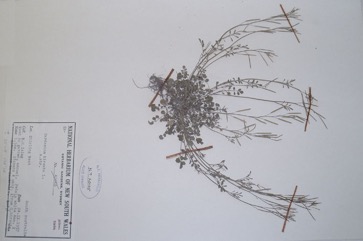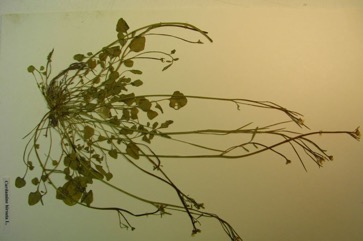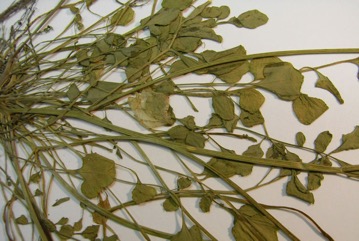Hairy bittercress

It is a temperate plant. It does best in humus rich, damp soils. It is frost resistant. It is drought tender. It grows in shady places. It grows in temperate and tropical zones. It grows on mountain slopes, roadsides, fields, clearings, wastelands, damp places, grassy areas; near sea level to 3000 m altitude in China. In Haiti it grows at about 1500 m. In Argentina it grows up to 2,000 m above sea level. Tasmania Herbarium.
Also known as:
Chantruk mana, Chantruk-maan, Common bittercress, Goj ao, Hairy wood cress, Kosanini, Lamb's cress, Mastuerzo cimarron, Monnyin, Oram-petsik, Serampeti, Serampidi, Splitting Jenny, Sui mi qi, Tosanini vu, Tsitsmat'ura, Veluri, Vlaknesta gorva, Wang ye gai
Synonyms
- Cardamine hirsuta var. formosana Hayata
- Cardamine regeliana Miquel
Edible Portion
- Leaves, Flowers
Where does Hairy bittercress grow?
Found in: Africa, Argentina, Asia, Australia, Brazil, Britain, Bulgaria, Caucasus, Central Asia, Chile, China, Cuba, Dominican Republic, East Africa, Europe, Falklands, Finland, Georgia, Haiti, Hawaii, Himalayas, India, Indochina, Indonesia, Ireland, Israel, Italy, Jamaica, Japan, Laos, Luxembourg, Malaysia, Mexico, Myanmar, New Guinea, New Zealand, Norfolk Island, North America, Northeastern India, Pacific, Pakistan, Papua New Guinea, PNG, Philippines, Scandinavia, SE Asia, Sikkim, South America, Sri Lanka, St Helena, Tasmania, Thailand, Turkey, Turkmenistan, Uruguay, United States, Vietnam, West Africa, SW Asia, S Africa, North and South America, West Indies, Zambia
Notes: There are about 160 Cardamine species. They are mostly in damp places in temperate regions.
Status: Leaves are sold in local markets.
Growing Hairy bittercress
Cultivation: Plants can be grown from seed. They can also be grown by dividing clumps.
Edible Uses: The leaves are peppery. The young leaves and flowers can be used in salads. They can also be cooked like spinach. The young roots are also eaten raw with vinegar and soy sauce.
Nutrition Info
per 100g edible portion| Edible Part | Energy (kcal) | Protein (g) | Iron (mg) | Vitamin A (ug) | Vitamin c (mg) | Zinc (mg) | % Water |
|---|---|---|---|---|---|---|---|
| Leaves | - | - | - | - | - | - | |
| Flowers | - | - | - | - | - | - |
Hairy bittercress Photos



References
Ambasta S.P. (Ed.), 2000, The Useful Plants of India. CSIR India. p 104 (var. sylvatica)
Angami, A., et al, 2006, Status and potential of wild edible plants of Arunachal Pradesh. Indian Journal of Traditional Knowledge 5(4) October 2006, pp 541-550
Bianchini, F., Corbetta, F., and Pistoia, M., 1975, Fruits of the Earth. Cassell. p 72
Bircher, A. G. & Bircher, W. H., 2000, Encyclopedia of Fruit Trees and Edible Flowering Plants in Egypt and the Subtropics. AUC Press. p 82
Bodkin, F., 1991, Encyclopedia Botanica. Cornstalk publishing, p 213
Bremness, L., 1994, Herbs. Collins Eyewitness Handbooks. Harper Collins. p 238
Brown, D., 2002, The Royal Horticultural Society encyclopedia of Herbs and their uses. DK Books. p 155
Bussman, R. W., et al, 2016, A comparative ethnobotany of Khevsureti, Samtskhe-Javakheti, Tusheti, Svaneti, and Racha-Lechkhumi, Republic of Georgia (Sakartvelo), Caucasus. Journal of Ethnobiology and Ethnomedicine (2016) 12:4
Cao, Y., et al, 2020, Ethnobotanical study on wild edible plants used by three trans-boundary ethnic groups in Jiangcheng County, Pu’er, Southwest China. Journal of Ethnobiology and Ethnomedicine (2020) 16:66
Crowe, A., 1997, A Field Guide to the Native Edible Plants of New Zealand. Penguin. p 71
Cribb, A.B. & J.W., 1976, Wild Food in Australia, Fontana. p 117
Curtis, W.M., 1956, The Students Flora of Tasmania Vol 1 p 35
Dashorst, G.R.M., and Jessop, J.P., 1998, Plants of the Adelaide Plains & Hills. Botanic Gardens of Adelaide and State Herbarium. p 68
Duke, J.A., 1992, Handbook of Edible Weeds. CRC Press. p 58
Ekman Herbarium records Haiti
Ertug, F, Yenen Bitkiler. Resimli Türkiye Florası -I- Flora of Turkey - Ethnobotany supplement
Facciola, S., 1998, Cornucopia 2: a Source Book of Edible Plants. Kampong Publications, p 57
Flora of China @ efloras.org Volume 8
Flora of Australia, Volume 8, Lecythidales to Batales, Australian Government Publishing Service, Canberra (1982) p 311
Flora of Australia Volume 49, Oceanic Islands 1, Australian Government Publishing Service, Canberra. (1994) p 141
Gangwar, A. K. & Ramakrishnan, P. S., 1990, Ethnobotanical Notes on Some Tribes of Arunachal Pradesh, Northeastern India. Economic Botany, Vol. 44, No. 1 pp. 94-105
Hedrick, U.P., 1919, (Ed.), Sturtevant's edible plants of the world. p 161
Henty, E.E., & Pritchard, G.S., 1973, Weeds of New Guinea and their control. Botany Bulletin No 7, Division of Botany, Lae, PNG. p 96
Hussey, B.M.J., Keighery, G.J., Cousens, R.D., Dodd, J., Lloyd, S.G., 1997, Western Weeds. A guide to the weeds of Western Australia. Plant Protection Society of Western Australia. p 116
Hu, Shiu-ying, 2005, Food Plants of China. The Chinese University Press. p 415 (As Cardamine regeliana)
Irving, M., 2009, The Forager Handbook, A Guide to the Edible Plants of Britain. Ebury Press p 86
Jain et al, 2011, Dietary Use and Conservation Concern of Edible Wetland Plants at Indo-Burma Hotspot: A Case Study from Northeast India. Journal of Ethnobiology and Ethnomedicine 7:29 p 6
Kang, Y., et al, 2012, Wild food plants and wild edible fungi in two valleys on the Qinling Mountains (Shaanxi, central China) Journal of Ethnobiology and Ethnomedicine; 9:26
Kizilarslan, C. & Ozhatay, N., 2012, An ethnobotanical study of the useful and edible plants of İzmit. Marmara Pharmaceutical Journal 16: 134-140, 2012.
Konsam, S., et al, 2016, Assessment of wild leafy vegetables traditionally consumed by the ethnic communities of Manipur, northeast India. Journal of Ethnobiology and Ethnomedicine, 12:9
Lazarides, M. & Hince, B., 1993, Handbook of Economic Plants of Australia, CSIRO. p 47
Low, T., 1991, Wild Herbs of Australia and New Zealand. Angus & Robertson. p 59 (Drawing)
Lokho, K. & Narasimhan, D., 2013, Ethnobotany of Mao-Naga Tribe of Manipur, India. Pleione 7(2): 314-324
Luczaj, L. et al, 2017, Comfrey and Buttercup Eaters: Wild Vegetables of the Imereti Region in Western Georgia, Caucasus. Economic Botany, 71(2), 2017, pp. 188–193
Mabey, R., 1973, Food for Free. A Guide to the edible wild plants of Britain, Collins. p 77
Malaisse, F., 1997, Se nourrir en floret claire africaine. Approche ecologique et nutritionnelle. CTA., p 59 (var. pilosa)
Malaisse, F., 2010, How to live and survive in Zambezian open forest (Miombo Ecoregion). Les Presses Agronomiques de Gembloux. (var. pilosa)
Malezas Comestibles del Cono Sur, INTA, 2009, Buernos Aires
Martin, F.W. & Ruberte, R.M., 1979, Edible Leaves of the Tropics. Antillian College Press, Mayaguez, Puerto Rico. p 188
Murtem, G. & Chaudhrey, P., 2016, An ethnobotanical note on wild edible plants of Upper Eastern Himalaya, India. Brazilian Journal of Biological Sciences, 2016, v. 3, no. 5, p. 63-81.
Nedelcheva A., 2013, An ethnobotanical study of wild edible plants in Bulgaria. EurAsian Journal of BioSciences 7, 77-94
Paczkowska, G. & Chapman, A.R., 2000, The Western Australian Flora. A Descriptive Catalogue. Western Australian Herbarium. p 185
Paoletti, M.G., Dreon, A.L., and Lorenzoni, G.G., 1995, Pistic, Traditional Food from Western Friuli, NE Italy. Economic Botany 49(1) pp 26-30
Pfoze, N. L., et al, 2012, Survey and assessment of floral diversity on wild edible plants from Senapati district of Manipur, Northeast India. Journal or Biodiversity and Environmental Sciences. 1(6):50-52
Pham-Hoang Ho, 1999, An Illustrated Flora of Vietnam. Nha Xuat Ban Tre. p 606
Plants for a Future database, The Field, Penpol, Lostwithiel, Cornwall, PL22 0NG, UK. http://www.scs.leeds.ac.uk/pfaf/
Plants of Haiti Smithsonian Institute http://botany.si.edu
Singh, H.B., Arora R.K.,1978, Wild edible Plants of India. Indian Council of Agricultural Research, New Delhi. p18
Steenbeeke, Greg as part of the Plants Directory project. List of plant species from northern NSW that may be used as food plants p 15
Taram, M., et al, 2018, Wild Food Plant Resources of Komkar Adi Tribe of Upper Siang District in Arunachal Pradesh, India. Bulletin of Arunachal Forest Research, Vol. 33(2), 27-35
Tasmanian Herbarium Vascular Plants list p 16
Tsering, J., et al, 2017, Ethnobotanical appraisal on wild edible plants used by the Monpa community of Arunchal Pradesh. Indian Journal of Traditional Knowledge. Vol 16(4), October 2017, pp 626-637
Upson, R., & Lewis R., 2014, Updated Vascular Plant Checklist and Atlas for the Falkland Islands. Falklands Conservation and Kew.
Wiriadinata, H., Ethnobotany of Economic Plants in the Baliem Valley, Jayawijaya, Irian Jaya, Indonesian Institute of Science, Bogor, Indonesia
World Checklist of Useful Plant Species 2020. Royal Botanic Gardens, Kew
Zhou Taiyan, Lu Lianli, Yang Guang; Ihsan A. Al-Shehbaz, BRASSICACEAE (CRUCIFERAE), Flora of China.